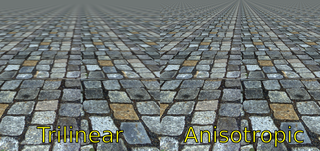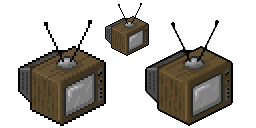Related Research Articles
ClearType is Microsoft's implementation of subpixel rendering technology in rendering text in a font system. ClearType attempts to improve the appearance of text on certain types of computer display screens by sacrificing color fidelity for additional intensity variation. This trade-off is asserted to work well on LCD flat panel monitors.

"Jaggies" is the informal name for artifacts in raster images, most frequently from aliasing, which in turn is often caused by non-linear mixing effects producing high-frequency components, or missing or poor anti-aliasing filtering prior to sampling.
In digital imaging, a pixel, pel, or picture element is the smallest addressable element in a raster image, or the smallest addressable element in an all points addressable display device; so it is the smallest controllable element of a picture represented on the screen.
In digital signal processing, spatial anti-aliasing is a technique for minimizing the distortion artifacts (aliasing) when representing a high-resolution image at a lower resolution. Anti-aliasing is used in digital photography, computer graphics, digital audio, and many other applications.

The GeForce 3 series (NV20) is the third generation of Nvidia's GeForce graphics processing units (GPUs). Introduced in February 2001, it advanced the GeForce architecture by adding programmable pixel and vertex shaders, multisample anti-aliasing and improved the overall efficiency of the rendering process.
In computer graphics, mipmaps or pyramids are pre-calculated, optimized sequences of images, each of which is a progressively lower resolution representation of the previous. The height and width of each image, or level, in the mipmap is a factor of two smaller than the previous level. Mipmaps do not have to be square. They are intended to increase rendering speed and reduce aliasing artifacts. A high-resolution mipmap image is used for high-density samples, such as for objects close to the camera; lower-resolution images are used as the object appears farther away. This is a more efficient way of downfiltering (minifying) a texture than sampling all texels in the original texture that would contribute to a screen pixel; it is faster to take a constant number of samples from the appropriately downfiltered textures. Mipmaps are widely used in 3D computer games, flight simulators, other 3D imaging systems for texture filtering, and 2D and 3D GIS software. Their use is known as mipmapping. The letters MIP in the name are an acronym of the Latin phrase multum in parvo, meaning "much in little".
Subpixel rendering is a way to increase the apparent resolution of a computer's liquid crystal display (LCD) or organic light-emitting diode (OLED) display by rendering pixels to take into account the screen type's physical properties. It takes advantage of the fact that each pixel on a color LCD is actually composed of individual red, green, and blue or other color subpixels to anti-alias text with greater detail or to increase the resolution of all image types on layouts which are specifically designed to be compatible with subpixel rendering.

In 3D computer graphics, anisotropic filtering is a method of enhancing the image quality of textures on surfaces of computer graphics that are at oblique viewing angles with respect to the camera where the projection of the texture appears to be non-orthogonal.
In computer graphics, texture filtering or texture smoothing is the method used to determine the texture color for a texture mapped pixel, using the colors of nearby texels. There are two main categories of texture filtering, magnification filtering and minification filtering. Depending on the situation texture filtering is either a type of reconstruction filter where sparse data is interpolated to fill gaps (magnification), or a type of anti-aliasing (AA), where texture samples exist at a higher frequency than required for the sample frequency needed for texture fill (minification). Put simply, filtering describes how a texture is applied at many different shapes, size, angles and scales. Depending on the chosen filter algorithm the result will show varying degrees of blurriness, detail, spatial aliasing, temporal aliasing and blocking. Depending on the circumstances filtering can be performed in software or in hardware for real time or GPU accelerated rendering or in a mixture of both. For most common interactive graphical applications modern texture filtering is performed by dedicated hardware which optimizes memory access through memory cacheing and pre-fetch and implements a selection of algorithms available to the user and developer.

Font rasterization is the process of converting text from a vector description to a raster or bitmap description. This often involves some anti-aliasing on screen text to make it smoother and easier to read. It may also involve hinting—information embedded in the font data that optimizes rendering details for particular character sizes.

Pixel-art scaling algorithms are graphical filters that are often used in video game console emulators to enhance hand-drawn 2D pixel art graphics. The re-scaling of pixel art is a specialist sub-field of image rescaling.

In computer graphics and digital imaging, imagescaling refers to the resizing of a digital image. In video technology, the magnification of digital material is known as upscaling or resolution enhancement.

Supersampling or supersampling anti-aliasing (SSAA) is a spatial anti-aliasing method, i.e. a method used to remove aliasing from images rendered in computer games or other computer programs that generate imagery. Aliasing occurs because unlike real-world objects, which have continuous smooth curves and lines, a computer screen shows the viewer a large number of small squares. These pixels all have the same size, and each one has a single color. A line can only be shown as a collection of pixels, and therefore appears jagged unless it is perfectly horizontal or vertical. The aim of supersampling is to reduce this effect. Color samples are taken at several instances inside the pixel, and an average color value is calculated. This is achieved by rendering the image at a much higher resolution than the one being displayed, then shrinking it to the desired size, using the extra pixels for calculation. The result is a downsampled image with smoother transitions from one line of pixels to another along the edges of objects.
Multisample anti-aliasing (MSAA) is a type of spatial anti-aliasing, a technique used in computer graphics to remove jaggies.

In the field of 3D computer graphics, deferred shading is a screen-space shading technique that is performed on a second rendering pass, after the vertex and pixel shaders are rendered. It was first suggested by Michael Deering in 1988.
Direct2D is a 2D vector graphics application programming interface (API) designed by Microsoft and implemented in Windows 10, Windows 8, Windows 7 and Windows Server 2008 R2, and also Windows Vista and Windows Server 2008.
Fast approximate anti-aliasing (FXAA) is a screen-space anti-aliasing algorithm created by Timothy Lottes at Nvidia.
TeraScale is the codename for a family of graphics processing unit microarchitectures developed by ATI Technologies/AMD and their second microarchitecture implementing the unified shader model following Xenos. TeraScale replaced the old fixed-pipeline microarchitectures and competed directly with Nvidia's first unified shader microarchitecture named Tesla.
Deep learning super sampling (DLSS) is a family of real-time deep learning image enhancement and upscaling technologies developed by Nvidia that are exclusive to its RTX line of graphics cards, and available in a number of video games. The goal of these technologies is to allow the majority of the graphics pipeline to run at a lower resolution for increased performance, and then infer a higher resolution image from this that contains the same level of detail as if the image had been rendered at this higher resolution. This allows for higher graphical settings and/or frame rates for a given output resolution, depending on user preference.
Deep learning anti-aliasing (DLAA) is a form of spatial anti-aliasing created by Nvidia. DLAA depends on and requires Tensor Cores available in Nvidia RTX cards.
References
- ↑ "MLAA: Efficiently Moving Antialiasing from the GPU to the CPU" (PDF). Intel . Retrieved 2018-12-02.
- ↑ "MORPHOLOGICAL ANTIALIASING AND TOPOLOGICAL RECONSTRUCTION" (PDF). Institut d'électronique et d'informatique Gaspard-Monge (IGM). Retrieved 2018-12-02.
- ↑ "Digital Foundry: The Future of Anti-Aliasing". Eurogamer. 2011-07-16. Retrieved 2018-12-02.
- ↑ "iryoku/smaa: SMAA is a very efficient GPU-based MLAA implementation". GitHub . Retrieved 2018-12-13.
- ↑ Jorge Jimenez and Jose I. Echevarria and Tiago Sousa and Diego Gutierrez (2012). "SMAA: Enhanced Subpixel Morphological Antialiasing". Computer Graphics Forum (Proc. EUROGRAPHICS 2012). 31 (2). JIMENEZ2012_CGF. Retrieved 2018-12-13.